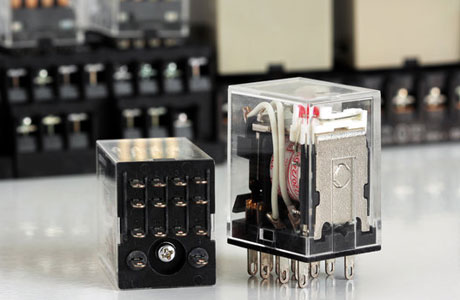Key Takeaway
A directional relay is a type of protective device that helps control power systems by determining the direction of current flow. It works by measuring the phase angle difference between current and voltage in the system. The relay uses this information, often derived from system voltage, to decide whether to activate and protect equipment like generators or transformers. Directional relays are crucial in managing faults in complex power grids, ensuring that issues are addressed promptly and power continues to flow in the correct direction, enhancing system reliability and safety.
Working Principle of Directional Relays
The working principle of directional relays revolves around the phase angle comparison between fault current and system voltage. These relays measure the angle difference to ascertain the direction of the fault current. When the measured angle surpasses a preset threshold, the relay recognizes the presence of a fault and triggers isolation of the affected section. This method ensures precise fault detection and isolation, reducing the risk of extensive damage.
Directional relays are equipped with a “directional element” that distinguishes between forward and reverse fault currents. This directional discrimination is achieved by comparing the polarities of the voltage and current waveforms. The relay responds only when the fault current flows in a specific direction, ensuring that only the faulty segment is disconnected, while the rest of the system remains operational. This selective operation enhances system reliability and minimizes downtime.

Applications in Power System Protection
Directional relays are widely used in power system protection, providing critical safeguards for various components. In transmission line protection, they detect and isolate faults by determining the direction of fault currents. This capability is essential for accurately identifying fault locations and preventing cascading failures.
In generator protection, directional relays safeguard against faults that can cause significant damage. By detecting the direction of fault currents, they ensure that generators operate under safe conditions. Additionally, in busbar protection, directional relays isolate only the faulted section, maintaining the integrity of the overall system and avoiding unnecessary shutdowns.
Directional relays are also crucial in differential protection schemes, where they compare currents entering and exiting a protected zone. In distance protection schemes, they measure impedance to the fault, enhancing fault location accuracy. These applications highlight the versatility and importance of directional relays in maintaining power system stability and reliability.
Types of Directional Relays
There are several types of directional relays, each suited for specific applications.
Electromagnetic Directional Relays: These relays use magnetic fields generated by fault currents to determine direction. They are simple and reliable, ideal for basic protection needs.
Electro-mechanical Directional Relays: Combining electromagnetic and mechanical components, these relays offer robustness and reliability for high-voltage applications. They are well-suited for harsh environments.
Solid-State Directional Relays: Utilizing electronic components, these relays provide high-speed operation and greater accuracy. They are perfect for modern digital protection systems.
Digital Directional Relays: Equipped with advanced microprocessors, these relays offer programmable settings, communication interfaces, and data logging capabilities. They are ideal for smart grid applications, providing flexibility and enhanced functionality.
Understanding the types of directional relays helps in selecting the right one for specific protection requirements, ensuring effective and efficient power system protection.
Setting and Configuring Directional Relays
Setting and configuring directional relays is a critical task that ensures optimal performance. Start by understanding the relay settings, such as pickup values, time delays, and directional settings. The pickup value is the minimum current level at which the relay operates, while the time delay prevents false tripping from transient currents.
Directional settings are adjusted based on system impedance and expected fault locations. This involves setting the angle at which the relay responds to fault currents. Accurate measurements and calculations are crucial for correct parameter settings. Tools like fault simulators and software programs aid in fine-tuning these settings.
After configuration, comprehensive testing is essential to verify relay performance under fault conditions. This testing phase ensures the relay functions as intended during real faults, safeguarding the power system effectively. Proper configuration and testing are paramount for maintaining system reliability and protection.
Benefits of Using Directional Relays
Directional relays offer numerous benefits, enhancing power system protection and reliability. One significant advantage is their ability to isolate faulted sections accurately, minimizing impact on the rest of the network. This selective fault isolation reduces downtime and prevents unnecessary outages, ensuring continuous operation.
Improved protection coordination is another benefit. Directional relays ensure precise fault detection, allowing only the affected section to be disconnected. This reduces wear and tear on unaffected equipment and enhances overall system stability.
Safety is also greatly enhanced with directional relays. By accurately determining fault direction, these relays prevent fault propagation, reducing the risk of extensive damage. Their use in advanced protection schemes supports the integration of renewable energy sources and smart grid technologies, paving the way for more efficient and resilient power systems.
Conclusion
Directional relays are indispensable for modern power system protection. Their ability to detect fault direction enhances reliability, safety, and efficiency. By isolating faults precisely and minimizing network impact, they ensure stable and continuous operation.
For new engineers, mastering the use of directional relays is crucial for designing and maintaining robust protection schemes. Embrace the knowledge and technology behind these relays to contribute effectively to the future of power system protection. Directional relays are not just about isolating faults; they are key to creating smarter, more reliable, and efficient power grids.
